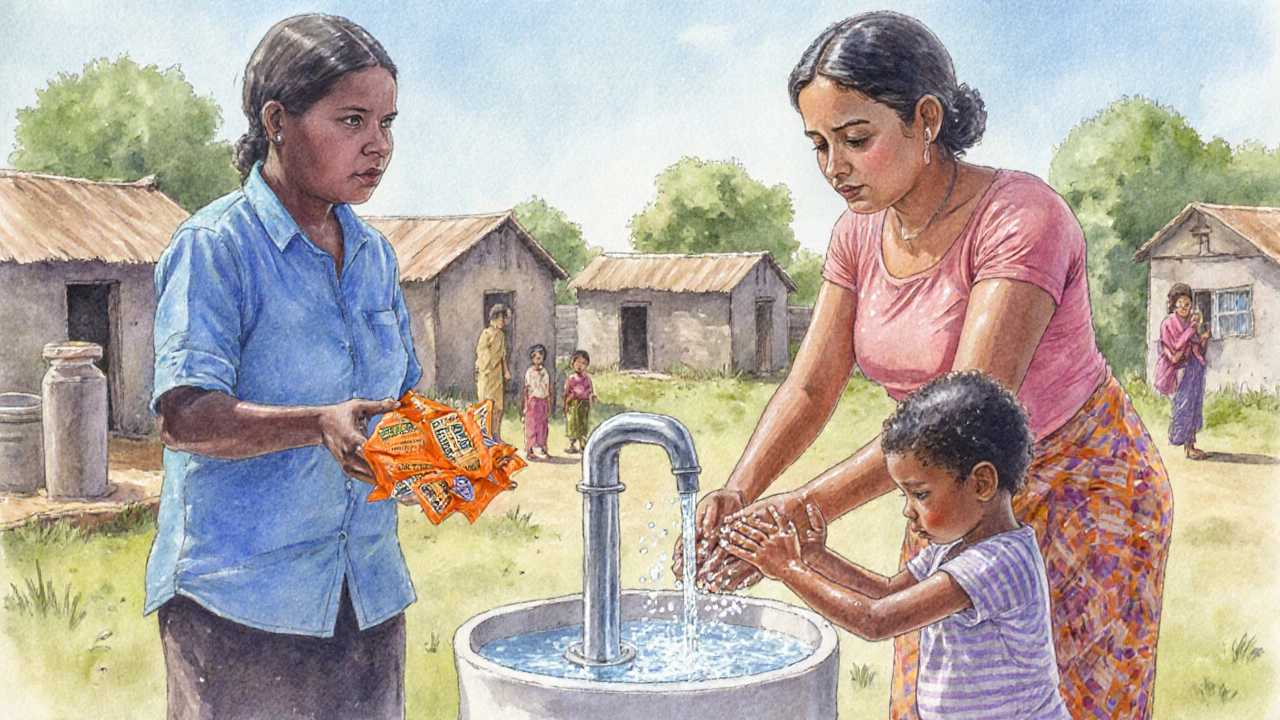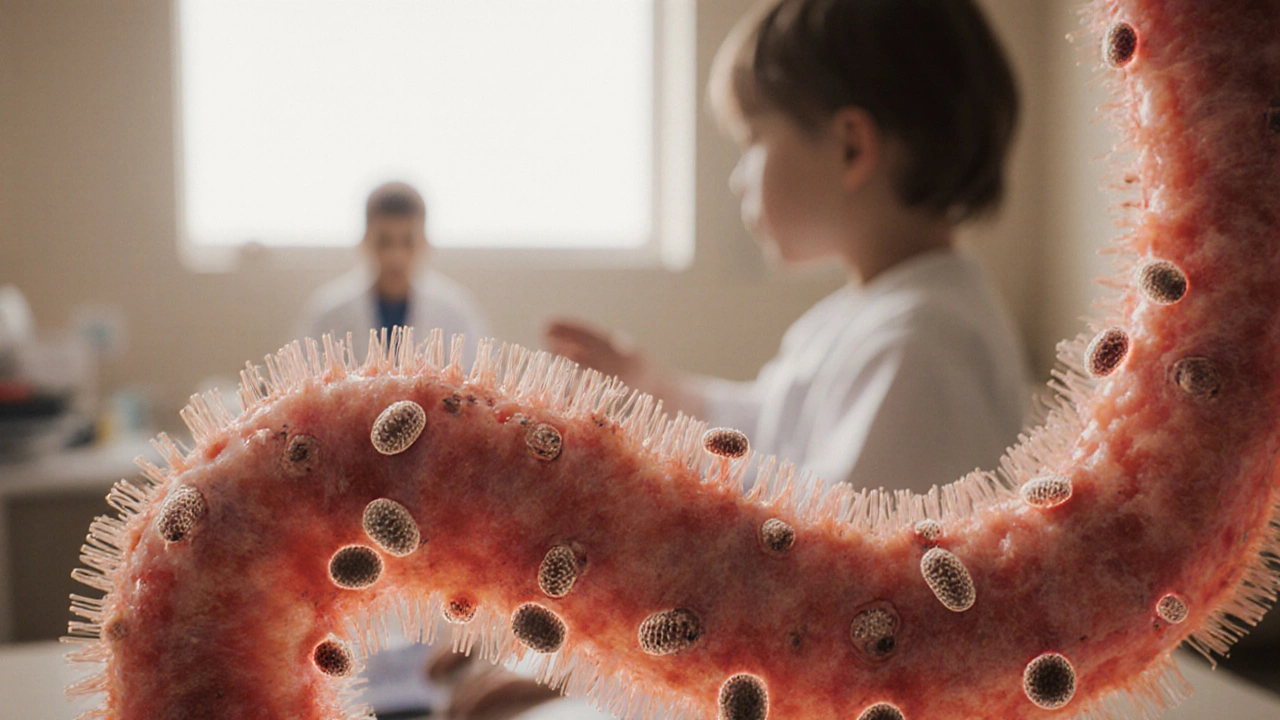Enteric Infection Impact Calculator
Enteric Infection Impact Assessment
This tool estimates the potential impact of repeated diarrheal episodes on nutritional status based on age group and frequency.
Estimated Impact

Key Takeaways
- Enteric infections damage the gut lining, lowering nutrient absorption and speeding up weight loss.
- Repeated bouts of diarrhea can cause stunting and micronutrient deficiencies, especially in children.
- Improving water quality, sanitation, and nutrition together cuts the infection‑nutrition cycle.
- Probiotic and micronutrient interventions can restore gut health and boost growth.
- Policy makers need integrated programs that tackle both infections and malnutrition simultaneously.
When tiny germs hijack the intestine, the body’s ability to use food drops dramatically. This relationship between enteric infections is a group of bacterial, viral, or parasitic diseases that affect the gastrointestinal tract and malnutrition is a state where the body lacks enough nutrients for growth, repair, and daily function isn’t new, but recent research shows the link is tighter than ever. A single episode of watery diarrhea can strip the gut of its lining, reduce the surface area for absorption, and trigger inflammation that keeps nutrients from getting into the bloodstream. For a toddler learning to walk, that setback can become a permanent growth delay.
Why does this happen? The gut is a living ecosystem, home to trillions of microbes that help break down food, synthesize vitamins, and guard against pathogens. When an enteric infection strikes, it often disrupts the gut microbiome, allowing harmful bacteria to overgrow while beneficial species dwindle. This imbalance, called dysbiosis, compromises the intestinal barrier, letting toxins leak into the bloodstream - a condition known as “leaky gut.” The immune system reacts, releasing cytokines that further damage the villi, the tiny finger‑like projections that scoop up nutrients.
In low‑resource settings, where clean water and proper sanitation are scarce, waterborne pathogens like Rotavirus, Shigella, and Giardia are the main culprits. A child can suffer several diarrheal episodes in a single year, each one eroding the gut’s absorptive capacity. Studies from South Asia and Sub‑Saharan Africa show that children who experience more than three episodes of moderate diarrhea before age two have a 30% higher risk of stunting - a form of chronic malnutrition where height‑for‑age falls below the normal range.
Stunting isn’t just about being short; it reflects long‑term deficiencies in protein, iron, zinc, and vitamin A. Those nutrients are essential for brain development, immune competence, and muscle strength. When the gut can’t absorb them, the body diverts what little it gets to critical organs, leaving growth plates starved. The result is a vicious cycle: malnutrition weakens immunity, making the child more susceptible to future infections, which in turn worsen nutritional status.
Beyond children, adults aren’t immune to the infection‑nutrition trap. In HIV‑positive individuals, for example, persistent diarrheal disease is a leading cause of weight loss and micronutrient depletion. The same mechanisms - villous atrophy, dysbiosis, and chronic inflammation - apply, but the clinical picture often includes muscle wasting (cachexia) rather than stunting.
Addressing this problem requires a two‑pronged approach: stop the infection and repair the gut. On the prevention side, improving water quality, promoting hand‑washing with soap, and ensuring latrine use are the low‑cost, high‑impact steps. The World Health Organization estimates that better sanitation could prevent up to 40% of diarrheal disease cases worldwide.
On the treatment side, oral rehydration salts (ORS) remain the cornerstone for acute diarrhea, but they don’t fix the nutrient gaps. Adding zinc supplements to ORS shortens the duration of diarrhea by about 25% and reduces the chance of a second episode within two weeks. For chronic or recurrent cases, probiotics such as Lactobacillus rhamnosus GG have shown promise in restoring a healthy microbiome balance, which in turn improves weight gain.
Nutrition interventions must also be tailored. Micronutrient powders (MNPs) that combine iron, zinc, and vitamin A can be sprinkled onto semi‑solid foods, delivering a therapeutic dose without changing taste. When paired with nutrition education - teaching caregivers how to prepare diversified meals from locally available foods - MNPs help close the gap between nutrient need and intake.
To illustrate the dual impact, consider the following comparison:
| Metric | Children (0‑2yr) | Adults |
|---|---|---|
| Average weight loss per episode | ~200g | ~1kg |
| Stunting risk increase | 30% per ≥3 episodes | Not applicable |
| Micronutrient deficiency prevalence | Iron‑deficiency anemia up to 45% | Zinc deficiency up to 25% |
| Recovery time with ORS+zinc | 4‑5days | 5‑7days |
| Improvement with probiotic therapy | +0.5kg weight gain over 2weeks | +1kg weight gain over 4weeks |
These numbers highlight that children suffer the most severe long‑term growth consequences, while adults experience more acute weight loss and muscle wasting. Both groups benefit from the same core interventions - clean water, ORS with zinc, and gut‑restoring therapies - but the dosing and monitoring differ.
Policy makers and program designers should therefore integrate nutrition and WASH (Water, Sanitation, Hygiene) strategies. For example, a community health worker can distribute ORS packets alongside fortified flour, while also conducting household checks for safe water storage. Health‑education sessions that explain the link between diarrhea and growth have been shown to increase caregiver compliance with both hygiene practices and micronutrient supplementation.
Monitoring progress requires reliable data. Simple anthropometric measurements (height‑for‑age, weight‑for‑height) capture stunting and wasting, while stool testing for pathogens identifies infection hotspots. Combining these data streams in a single dashboard helps allocate resources where the infection‑nutrition cycle is most entrenched.
Looking ahead, research is exploring next‑generation solutions. Synbiotic formulations - a mix of prebiotics (fibers that feed beneficial bacteria) and probiotics - aim to rebuild the microbiome faster than traditional approaches. Meanwhile, rapid diagnostic kits that detect multiple diarrheagenic pathogens in under 30minutes are becoming more affordable, allowing health workers to target treatment more precisely.
In practice, the biggest gains still come from low‑tech, high‑impact actions: treating every diarrheal episode with ORS plus zinc, ensuring children receive age‑appropriate micronutrient powders, and keeping hands clean. When these steps are consistently applied, the gut heals, nutrient absorption improves, and children start to grow on track.

Frequently Asked Questions
Can a single bout of diarrhea cause permanent damage?
One short episode usually heals quickly, but repeated or severe diarrheal episodes can lead to lasting villous atrophy, especially in children under two. The damage becomes harder to reverse the more often it occurs.
Why is zinc added to oral rehydration salts?
Zinc shortens the duration of diarrhea, reduces stool output, and supports the immune system. Clinical trials show a 25% faster recovery when zinc is included.
Are probiotics safe for malnourished children?
Yes, most strains like Lactobacillus rhamnosus GG have a strong safety record. They can help restore gut balance and improve weight gain when combined with proper nutrition.
What’s the difference between stunting and wasting?
Stunting reflects chronic undernutrition and is measured by height‑for‑age. Wasting indicates acute weight loss and is measured by weight‑for‑height. Both can stem from enteric infections, but stunting is more closely linked to repeated episodes.
How can communities reduce the infection‑malnutrition cycle?
Integrate clean‑water projects, hand‑washing promotion, nutrition education, and distribution of ORS‑zinc kits. Regular monitoring of growth and stool testing helps target interventions where they’re needed most.


3 Comments
Jeremy Olson
4 October, 2025The connection between enteric infections and micronutrient deficiencies is indeed a critical public‑health issue.
Repeated diarrheal episodes compromise the intestinal villi, which reduces nutrient absorption and predisposes children to stunting.
Integrating WASH interventions with targeted micronutrient supplementation, as the article suggests, offers a pragmatic pathway to break this cycle.
Moreover, community health workers can play a pivotal role in monitoring growth metrics and ensuring timely treatment.
Ada Lusardi
21 October, 2025Wow, the numbers are eye‑opening! 😮
Pam Mickelson
19 December, 2025I love how the piece breaks down the microbiome’s role in nutrient uptake.
The description of dysbiosis and leaky gut really helps demystify the physiology for non‑experts.
Highlighting zinc’s impact on shortening diarrhea duration is especially useful for field programs.
It’s also great to see probiotics mentioned as a realistic adjunct therapy.
Overall, the article offers clear, actionable steps for both clinicians and policymakers.